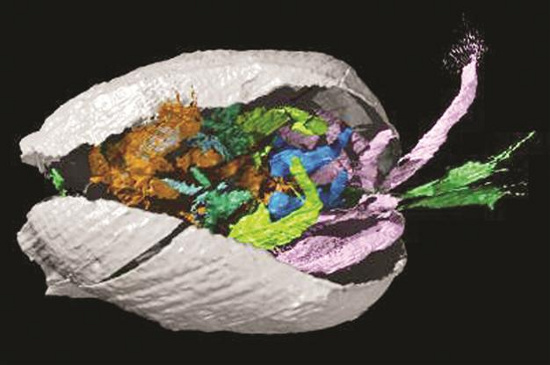Finding fossils with extremely rare soft tissue
(a group of researchers) has made an extremely rare discovery of an animal with features such as crab, lobster and shrimp. This creature is also a mystery to science.
Scientists from Leicester, Oxford, Imperial and Yale universities have published fossil discoveries of a new and important species with ostracod science in Proceedings of The Royal Society B. The research is funded by the Natural Environment Research Council.
The species were discovered, about 10mm long, especially because the fossils are well preserved, complete with not only the shell but also body software such as legs, eyes, gills and digestive system. Such discovery is extremely rare in fossils.
These tiny shelled arthropods are about 425 million years old, discovered in Herefordshire, Welsh Borderland. The stones in this region were identified with the same geological time as the Silua period, when the south of England was also a sea area on a small continent located in the south of the warm subtropical latitude. Ostracods and related sea creatures are already covered by a volcanic ash screen and they were preserved in frozen at that time.

Professor David Siveter of the University of Leicester Geology, said: "The two ostracod specimens discovered represent a new genus and species with science, named Pauline avibella . This name is named. "A special person and avibella's participation means a beautiful bird. The naming is because scientists associate a striking feature of the shell with a bird's wing."
"Ostracods fossilized arthropods were once the richest species, appearing everywhere in rocks 490 million years ago, and are common in today's aquatic environment."
The conservation of soft tissue parts of animals is a very rare case in fossils and allows great insight into the structure of ancient biological communities, and the evolution of animals - events That is important if not lost to science. Fossils known from the Herefordshire region suggest that the preservation of soft tissues is important for the globe.
The fossils have been rebuilt quite similarly, using a technique that involves grinding each sample, layer, and taking photos at each stage. 10mm is relatively small, but at an increased level to 20mm (micrometer) with 500 slices, which can then be assembled together in a computer to provide complete external and internal holograms of every fossil.
Professor Siveter added: "Fossil discovery generally helps to clarify our position in the tree of life. This discovery adds a part of knowledge in assembling more understanding of diversity. and the evolution of animals ".
"It is interesting to discover that a common group of fossils that we think we know a lot may have been deceived in their actual identity, which we now recognize. is a beautiful fossil of soft tissue A case of a wolf wearing sheep's clothing ".
The study was conducted with Professor Derek Siveter and Dr. Sarah Joomun (Oxford), Dr. Mark Sutton (Imperial College London) and Professor Derek Briggs (Yale, USA).
- Dinosaurs have them with ... chickens?
- Can soft tissue of dinosaurs really exist?
- New X-ray technology can see soft tissue
- Detection of extremely rare dinosaur fossils in the UK
- Soft tissue lesions in children
- America: A farmer finds the mammoth skeleton in his yard
- Soft tissue found in frog fossils
- Very rare fossils of gibbons
- Found fossils of new dinosaurs
- Unexpectedly caught the extremely rare shark after nearly a decade
- Artificial wombs help discover embryonic development secrets
- Oral tissue lesions in children
 Discovered an ancient centipede fossil 99 million years old
Discovered an ancient centipede fossil 99 million years old Discovered bat-like dinosaurs in China
Discovered bat-like dinosaurs in China Discovered a 200-year-old bronze cannon of the coast
Discovered a 200-year-old bronze cannon of the coast Discover 305 million-year-old spider fossils
Discover 305 million-year-old spider fossils